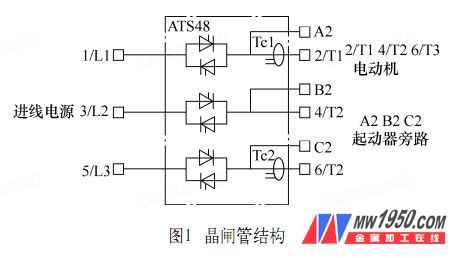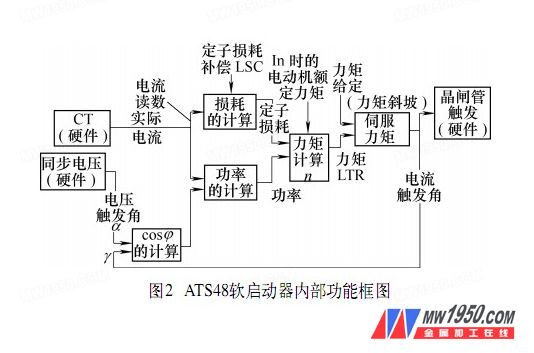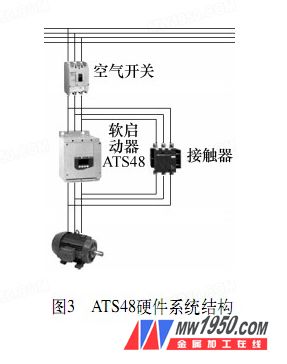Application of Schneider ATS48 soft starter in chillers
With the continuous development of the social economy, the supply of cooling, heating and hot water for public buildings and residential buildings has become a common demand. In the traditionally designed air conditioning system, the chiller is used for cooling and the boiler is heated, or the lithium bromide unit is used to provide both cold water and hot water. The use of boilers as heat sources has the problems of high environmental pollution and high operating costs. The use of chillers to operate heat pumps and provide hot water can improve the overall energy efficiency ratio of chillers and reduce energy consumption. At the same time, if the chiller adopts the horizontal shell-and-tube condenser and the shell-and-tube evaporator, it has the characteristics of simple structure, stable heat exchange, long-lasting efficiency and convenient maintenance. It is also the most ideal structural component of the central air-conditioning main unit. Generally, the main motor start of the chiller adopts the star-delta electromechanical start control mode. Since the contactor is burned and the current flows during the start-up of the motor, the contacts of the contactor are burned out and need to be replaced frequently. Contactor, maintenance is very troublesome. In order to ensure the reliable operation of the unit and reduce the failure rate, the Schneider ATS48 soft starter is used to control the start and stop action of the main motor of the chiller. By controlling the gate trigger control circuit of the thyristor SCR, the starting current of the motor in the chiller is controlled and limited. . During the entire starting process, the starting current of the motor is more stable, reducing the impact on the grid, and there is no transient current. Secondly, the soft-start mode can be adjusted during the entire startup process, the start-up time, and the limiting current, which is more flexible for applications. The ATS48 soft starter achieves the purpose of controlling the start and stop of the motor by controlling the voltage output to the motor and the motor torque. The way to achieve this is by using a thyristor SCR power switching element. For a thyristor, a single thyristor will only allow current to flow in one direction if the gate control circuit is added with a control signal. Since the soft starter is used for the AC circuit, two thyristors SCR are required for each phase, which are connected in anti-parallel connection with each other, so that the current can flow in both directions. For the three-phase load, a total of six thyristors are required. The connection diagram is shown in Figure 1. During the initial start-up phase, current and acceleration time control is achieved by triggering control of the thyristor at different times in the second half of the waveform. The later the thyristor gate trigger pulse is triggered during the entire cycle, the less waveform is passed and the corresponding output voltage is lower. Similarly, if the trigger pulse is triggered earlier in the entire cycle, the more waveforms passed, the higher the corresponding output voltage. Therefore, the output voltage of the motor is controlled by the trigger control of the thyristor, so that the acceleration characteristics and the inrush current of the motor are effectively controlled. Because the ATS48 adopts the torque control mode, the actual current detection of the motor is used to estimate the power magnitude and power loss, thereby obtaining the torque value, and comparing with the actual torque reference value to control the trigger of the thyristor to achieve the purpose of torque control. Unlike ordinary soft starters, the conventional soft starter only controls the voltage output to the motor, and the actual motor torque is proportional to the square of the voltage, causing the entire starting process to be not very smooth, especially in the second half of the acceleration process. The ATS48 soft starter completely eliminates this phenomenon through the torque control mode. The internal functional block diagram of the ATS48 soft starter is shown in Figure 2. When the soft starter thyristor is fully turned on, a relay output signal is issued to activate the bypass contactor, and the current in the loop is transferred from the soft starter to the bypass contactor, which reduces the conduction of the power tube during normal operation. Energy loss while extending the life of the contactor. The bypass control structure is used during operation to reduce the heat loss caused by the thyristor inside the soft starter. When the system sends a stop signal, the soft starter thyristor is fully turned on, and the bypass contactor circuit is cut off, and the current in the loop is switched back from the bypass contactor to the thyristor and flows through the power tube. See the ATS48 hardware system block diagram (see Figure 3). (1) The torque control mode makes the soft start soft stop more stable. The Schneider ATS48 soft starter torque control mode does not simply control the output voltage to start, but the control output torque linearly increases or decreases, avoiding the startup too fast in the later stage of startup ( The voltage and torque are squared, so the motor starts and stops more smoothly. (2) Arcless switching The design of the bypass structure extends the life of the contactor contacts. The bypass contactor does not have to withstand large current surges during closing and breaking during the action of a direct-start or star-delta-actuated contactor, but only through normal operating current. Therefore, the contact arcing of the contactor is not caused, and the life of the contactor is prolonged. (3) Reducing power loss The design of the bypass structure reduces the heat generated by the voltage drop of the thyristor, which increases the efficiency of the system and eliminates the problems of reliability and maintenance. (4) Digital control Schneider ATS48 soft starter uses microprocessor to analyze the actual feedback current of the motor, optimizes the trigger control of the thyristor through torque control calculation, and eliminates the problem of the huge number and size of the components in the analog circuit. In comparison, digital circuits are used, the structure is very compact, the reliability is greatly improved, and the service life is greatly extended. (5) No need for thermal relay protection The ATS48 soft starter itself has motor thermal protection. Due to the clever internal design, the motor current flows through the bypass contactor terminal after bypassing, and then through the current transformer to the motor, so it still works. (6) Fault detection and protection function Schneider ATS48 soft starter has powerful protection function, phase loss protection, phase sequence protection and overload protection, which can reduce some components in the primary and secondary circuits and save costs. In addition, the soft starter's powerful human-computer interaction makes the fault detection handy, which is unmatched by the star-angle startup. (7) Communication function is easy to integrate in the whole system Most soft starters integrate modbus communication interface, and can also be integrated into Ethernet and profibus network through gateway, making central monitoring easier. The application of the soft starter in the chiller can improve the performance and reliability of the whole system, improve the operating efficiency of the system, and reduce the maintenance cost. And through the communication function of the ATS soft starter, the central control unit of the system monitors the operation of each chiller at any time, reduces the amount of equipment maintenance work, and improves the intelligence of the entire control system. Stainless Steel Ball Valves,Butterfly Valve,1Pc Ball Valve,2Pc Ball Valve WENZHOU LUWEI VALVES AND FITTINGS CO.,LTD , https://www.stainlesssss.com 1. How does ATS48 work?


2. Application of bypass contactor

3. Advantages of using the Schneider soft starter ATS48 to control the chiller
4. Conclusion